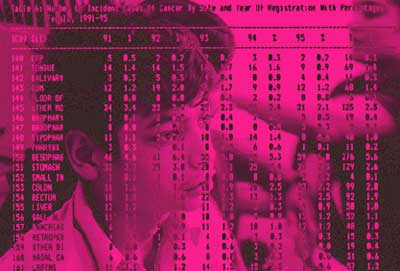Faceless Figures
 Room number eight is located in a nondescript corner of the All India Institute of Medical Sciences (aiims), New Delhi. Gauri Prasad regularly visits this room, which stores medical histories of cancer patients. A resident of Panipat, Haryana, Prasad has been afflicted with lymphoma for the past five years. Now in his third relapse, he wonders why the killer keeps resurfacing even though he has undergone chemotherapy twice. The stacks of files inside the room mean nothing to Prasad’s oncologist. "I have treated thousands of patients. Yet I know so little," he says. The story repeats itself in hundreds of hospitals across India. "There are typical questions a patient invariably asks," says Rajeev Agarwal, a surgical oncologist at Sir Ganga Ram Hospital, New Delhi.Why do I have the disease? How long will I live and how much would I have to spend? A nation with a billion people knows very little about the killer though arguably there are one billion reasons to find out. Desperately.
Room number eight is located in a nondescript corner of the All India Institute of Medical Sciences (aiims), New Delhi. Gauri Prasad regularly visits this room, which stores medical histories of cancer patients. A resident of Panipat, Haryana, Prasad has been afflicted with lymphoma for the past five years. Now in his third relapse, he wonders why the killer keeps resurfacing even though he has undergone chemotherapy twice. The stacks of files inside the room mean nothing to Prasad’s oncologist. "I have treated thousands of patients. Yet I know so little," he says. The story repeats itself in hundreds of hospitals across India. "There are typical questions a patient invariably asks," says Rajeev Agarwal, a surgical oncologist at Sir Ganga Ram Hospital, New Delhi.Why do I have the disease? How long will I live and how much would I have to spend? A nation with a billion people knows very little about the killer though arguably there are one billion reasons to find out. Desperately.
Yet the medical establishment can’t even pin point how many people are killed by cancer. ‘One of the top ten killers,’ an uncertain government document will inform you. With the cancer registries making cold entries of cancer patients into thick registers, since 1982, Indian medical bureaucracy’s understanding of the disease has almost come to an end. Way back in 1975 a National Cancer Control Programme (nccp) was set up recognising the emergence of the deadly killer. It is frightening to note that 27 years later the programme remains baffled and static as it fails to generate a comprehensive data bank of the disease, which can give vital clues to understand cancer. The National Cancer Registry Programme (ncrp), coordinated by the Indian Council of Medical Research (icmr), New Delhi, has brought out just seven registry reports though it was established more than two decades ago. The last report was published in 1992 for the year 1988-89. And even these are very rudimentary, revealing just the tip of the iceberg. icmr plans to publish the next set of data only in January 2002
